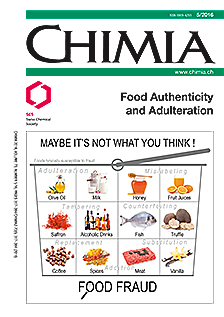Use of Isotope Ratio Determination (13C/12C) to Assess the Production Method of Sparkling Wine
DOI:
https://doi.org/10.2533/chimia.2016.338Keywords:
Ancestral method, Closed tank, Isotopic ratio, Sparkling wine, Traditional methodAbstract
The production of a sparkling wine can be performed with different methods taking from a few weeks to several years, which often justifies a difference in added value for the consumer. This paper presents the use of isotope ratio ?13C measurements combined with physico-chemical analyses for the determination of mislabelling of sparkling wines produced by 'ancestral', 'traditional', 'closed tank' or 'gasification' methods. This work shows that the isotope composition of CO2 compared with that of the corresponding dried residue of wine (DRW) can assess whether carbonate CO2 in a sparkling wine originates from alcohol fermentation or from artificial gas addition. Isotopic ratios expressed as ?13CCO2 and ?13CDRW measurements have been obtained for each wine by gasbench isotopic ratio mass spectroscopy and cavity ring down infrared spectroscopy, respectively. When the difference between ?13CCO2 and ?13CDRW is negative, the presence of artificial CO2 can be undoubtedly inferred, which would exclude the production methods 'ancestral' or 'traditional' for instance. Other parameters such as alcohol content, sugar and acid distributions are also important to complete the analytical panel to aid fraud tracking.Downloads
Published
2016-05-25
Issue
Section
Scientific Articles
License
Copyright (c) 2016 Swiss Chemical Society

This work is licensed under a Creative Commons Attribution-NonCommercial 4.0 International License.
How to Cite
[1]
J. S. Rossier, V. Maury, L. Gaillard, E. Pfammatter, Chimia 2016, 70, 338, DOI: 10.2533/chimia.2016.338.







